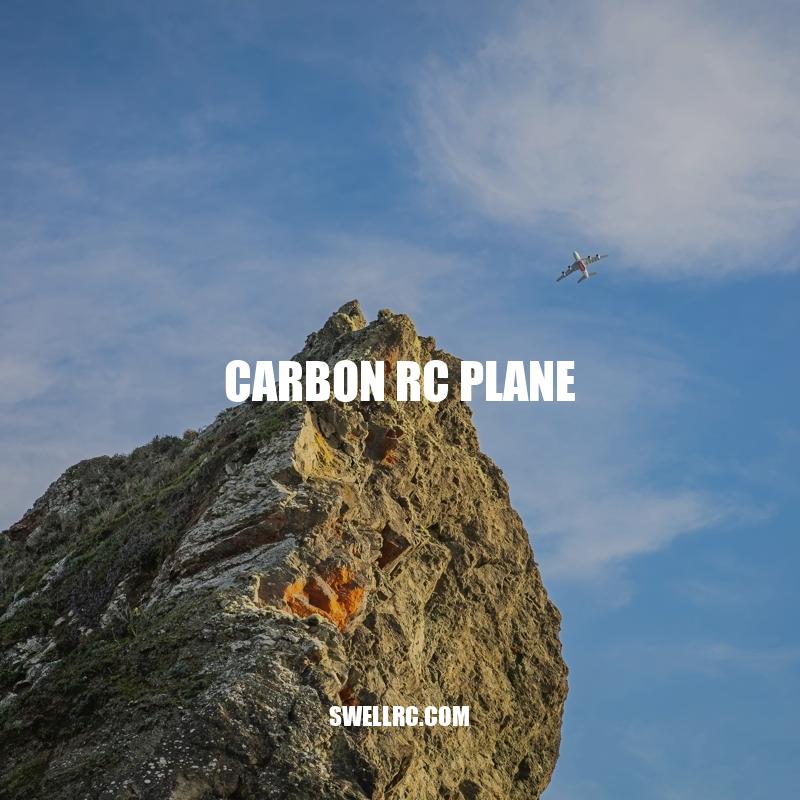Unleashing the Power of Carbon RC Planes: A Guide to Choosing the Right Model
Carbon RC planes are becoming increasingly popular among remote control aircraft enthusiasts. These planes are constructed using high-quality, lightweight carbon fiber materials that help to boost their flight performance and durability. Carbon fiber is a popular material in a variety of industries, including aerospace, and this has translated well to the world of RC planes. Carbon RC planes are lighter, faster, and more aerodynamic than traditional planes, which makes them ideal for those looking to take their hobby to the next level. They are also more resistant to crashes and other accidents, which means that they are ideal for beginners and experienced pilots alike. Due to their impressive design and construction, carbon RC planes can outperform other types of remote-controlled planes in terms of speed, maneuverability, and acrobatics. There are several types of carbon RC planes available, with each type tailored to a specific kind of flying style or preference. Choosing the right type of plane will depend on your goals, experience, and budget. In this article, we will go over the benefits of owning a carbon RC plane, the different types available, and what features to consider when selecting the right plane for your needs.
Benefits of Carbon RC Planes
Carbon RC planes offer a range of benefits that make them an attractive option for hobbyists and pilots alike. Here are some key advantages to owning a carbon RC plane:
- Lightweight design: Carbon fiber materials are incredibly lightweight, which means that carbon RC planes can fly faster and more smoothly than traditional planes.
- Durability: Carbon fiber is stronger than other materials, which makes carbon planes more resistant to crashes and other accidents.
- Reduced drag: Carbon fiber construction reduces drag, which helps to boost speed and aerodynamics.
- Superior performance: Carbon RC planes offer unparalleled performance in terms of speed, maneuverability, and acrobatics. Their design and construction make them ideal for pilots looking to take their hobby to the next level.
If you’re interested in purchasing a carbon RC plane, there are several online retailers where you can find a wide range of models to choose from. Websites such as Horizon Hobby, Tower Hobbies, and HobbyKing offer a variety of carbon RC planes at different price points, with features that cater to both beginner and experienced pilots. Don’t forget to consider the features discussed in the next section when selecting the right plane for you.
What are the benefits of carbon fiber airplanes?
One of the benefits of carbon fiber airplanes is that they are lighter and stronger than their metal counterparts. Other benefits include:
- Reduced fuel consumption
- Improved range and payload capacity
- Higher resistance to corrosion
- Increased lifespan and durability
- No fatigue-related maintenance issues
- Better engineering flexibility
Carbon fiber airplanes are becoming increasingly popular among aviation manufacturers due to these advantages. To learn more about this technology and its benefits, you can visit websites like compositesworld.com or carbonfiberaircraft.com.
Types of Carbon RC Planes
There are several types of carbon RC planes available, each designed with specific features and functions. Here are some of the most popular types of carbon RC planes:
| Plane Type | Description | Pros | Cons |
|---|---|---|---|
| Sport Planes | Designed for speed and agility |
|
|
| 3D Planes | Designed for acrobatic stunts and maneuvers |
|
|
| Scale Planes | Modeled after real-life planes |
|
|
Each type of carbon RC plane has its advantages and disadvantages. It is important to choose the type that best suits your interests and skill level. Additionally, each plane can have unique features that cater to specific flying preferences, such as the number of channels on the remote control or the type of battery required for operation. Some interesting facts about carbon RC planes include:
- The first carbon RC plane was developed in the 1960s by aerospace engineers looking to demonstrate the potential of carbon fiber as a construction material.
- Carbon fiber is now widely used in the aerospace industry to build high-performance planes and spacecraft.
- Carbon RC planes can reach speeds of up to 200 mph.
- The largest carbon RC plane ever built had a wingspan of over 28 feet and weighed over 500 pounds.
Several websites, including Amazon, offer a variety of options for those looking to purchase a carbon RC plane. It is important to do research ahead of time to ensure that you are purchasing from a reputable seller and to consider the features that are important to you.
How many types of RC planes are there?
There are several types of RC planes available in the market, including:
- Trainer planes – easy to fly and perfect for beginners
- Pattern planes – designed for aerobatic maneuvers and precision flying
- Scale planes – looks like a real airplane and mimics its flying behavior
- Sport planes – versatile planes for different types of flying and stunts
- Warbird planes – replicas of military planes and designed for dogfight simulations
- 3D planes – capable of performing incredible acrobatics and stunts in 3D space
For more information about RC planes, you can visit websites like Horizon Hobby, Motion RC, and HobbyKing that offer a wide range of RC planes, accessories, and resources for enthusiasts.
Features to Look for When Choosing a Carbon RC Plane
When selecting a carbon RC plane, it is important to consider several features to ensure that you get the most out of your purchase. Here are some key features to consider when choosing a carbon RC plane:
- Plane Design: Consider the design of the plane, including its shape, wing span, and weight. Models with longer wingspans tend to handle better in the air and can stay aloft for longer periods of time, whereas heavier planes may be more stable but slower.
- Motor Power: The power and torque of the plane’s motor can affect its speed and agility. Be sure to choose a motor that matches your pilot skills and preferences.
- Battery Life: The battery life of the plane impacts how long it can stay aloft in the air. Consider the battery type and life span when selecting your plane, and be sure to invest in additional batteries if necessary.
- Control: Consider the type of remote control required for the plane, including the number of channels available and the range of control. A remote control with more channels will offer greater control of the plane, but may require more skill to operate fully.
Some other features to consider when choosing a carbon RC plane include:
- Range: Consider the range that the plane is capable of flying, as well as its signal strength and transmission reliability.
- Accessories: Consider any accessories that come with the plane, such as replacement parts, batteries, or a carrying case.
There are several websites that offer high-quality carbon RC planes, including Motion RC and Horizon Hobby. Each website offers a range of models with different features and functions, and their customer reviews can help to guide your purchase decision. Additionally, be sure to check out YouTube videos of different carbon RC plane models to see how they perform in the air.
How do I choose the right motor for my RC plane?
Choosing the right motor for your RC plane depends on various factors such as the weight of the plane, the size and pitch of the propeller, and the desired flight performance. Here are some steps to consider when selecting a motor for your RC plane:
1. Determine the weight of your plane, including the battery and all other components.
2. Determine the required thrust-to-weight ratio for your desired flight performance. This can vary depending on whether you want a gentle or aggressive flight style.
3. Look for motors that can provide the required thrust-to-weight ratio for your plane’s weight and desired flight style.
4. Consider the size and pitch of the propeller that you want to use and ensure that the motor you choose is compatible.
5. Check the specifications of the motor, including the maximum current draw and voltage rating, to ensure that they are within the limits of your ESC and battery.
There are several websites and products that can help you select the right motor for your RC plane. For example, HobbyKing has a motor selection guide that can help you narrow down your options based on your plane’s weight and desired performance. Another great resource is Flite Test, which offers a wide range of articles and videos on selecting the right components for your RC plane.
Is a Carbon RC Plane Right for You?
If you are looking to take your RC hobby to the next level, a carbon RC plane may be a great option for you. Not only do they offer superior performance and durability compared to traditional RC planes, but they also provide a level of challenge and excitement that can be incredibly rewarding.
However, it is important to keep in mind that carbon RC planes require a higher level of skill when it comes to operation and maintenance. As such, they may not be the best option for beginners or those new to the hobby. It is important to take your time and learn the necessary skills before investing in a carbon RC plane to ensure that you get the most out of your investment.
In conclusion, carbon RC planes are an excellent investment for those looking to take their RC hobby to the next level. Their superior performance, durability, and handling make them stand out from traditional RC planes. However, it is important to ensure that you select the right model for your skill level and preferences, and to take the necessary steps to learn how to operate and maintain it properly. With some patience and practice, you can enjoy a challenging and rewarding experience with a carbon RC plane.



